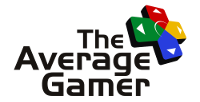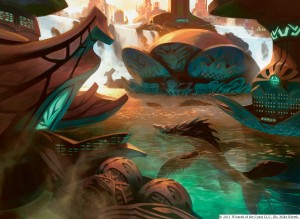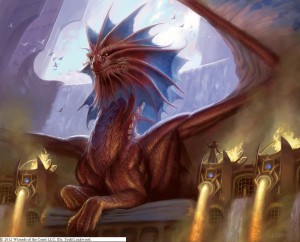Friday Night Unplugged #12: Magic:The Gathering – Gatecrash
- Updated: 1st Feb, 2013
Hello and welcome to this week’s Friday Night Unplugged. At the beginning of the year we talked about Android: Netrunner, a 2-player living card game based on a collectible card game of the same name. This week we’re looking at what is probably the most popular CCG in the world, Magic: The Gathering (M:TG) as a celebration of the newly-launched Gatecrash set. Here’s why you should be paying attention to M:TG if you’re a fan of card games and why now is a great time for new players to start.
What is Magic: The Gathering?
Magic: The Gathering is a fantasy based trading card game by Wizards of the Coast (WoTC), where players collect cards and build decks to battle each other with. Players collect cards through randomly packed boosters or by purchasing pre-built intro/event decks, they can also buy singles online and can play each other at home or at officially designated Friday Night Magic or FNM events. It’s also huge on a competitive scale. Like e-sports, there are events held worldwide for those looking to play on a professional level. Star City Games are one such promoter who run a majority of the larger events.
So how does it work?
M:TG is mostly played 1v1. Each player has a deck they either built themselves or came pre-built and starts with 20 life points and 7 cards from the top of their deck in hand. Each player takes it in turns from then on, though it’s possible to interrupt your opponent’s turn with the right card.
The aim of the game is to reduce your opponent’s life to 0. You can also win if the opposing player concedes or runs out of cards in their deck.
In Magic, you generate mana through land cards (a maximum of one land card can be played per turn) that produce different coloured mana, which can then be used to summon creatures – which can attack or block incoming attacks – or other cast spells such as sorceries and enchantments. If you want more detailed info then head over to the WoTC What is Magic? page or download the Learn to Play software for free.
What’s Gatecrash?
The new set Gatecrash launches today and is the second part of the Return to Ravnica block, set in the city plane of Ravnica. In this world the city’s 10 controlling guilds are at war and they’re ripping it apart in the process.
The theme itself is cool but what makes Gatecrash and its predecessor Return to Ravnica (RTR) so great for new players is the way it handles the Mana colours. Traditionally the bulk of a set is made up of of 5 different coloured cards, white, blue, black, red and green. These represent different types of magic and creatures. Black is usually more selfish and based around demons, vampires, zombies and more, while green is a creature-focused colour more based around nature.
In the RTR block the majority of the set is made up of dual coloured guilds. The Golgari guild wield green and black based on the cycle of life and death and the blue/green Simic guild are of evolution and biomancy. It’s easier than ever to learn to play with these cards, as building decks across multiple colours is not just fun but actually supportable due to the dual coloured lands available to keen deckbuilders.
That sounds good, what’s the downside?
Magic: The Gathering for the most part is cheap to play. Picking up a few intro packs and a booster every now and then is enough for people who just want to play but what if you want to play more than at home? Weekly FNM events mean there is always something for people to play, whether you want to just play casual or not.
If you’re the type of person who loves to collect, wants to play at every draft event or tournament and win, then that’s where the costs start going up. Cracking boosters open looking for that one card you need gets expensive and buying single cards online although at a higher price for a single card does become more cost effective. Keeping competitive means keeping up with sets as they rotate in and out and being prepared for old sets to no longer be tournament-legal. It all depends on what you’re looking for in a card game.
I’m interested, tell me more.
In my opinion there are a few reasons you will probably love Magic: The Gathering, lets take a look.
You love to design and create: Lead designer of the majority of the recent M:TG releases Mark Rosewater recently said in the DailyMTG podcast that to him, M:TG is a game for game designers and I believe that’s true. What M:TG gives you is a toolkit. Each card is a different piece, with different upsides and downsides and with hundreds of cards available, you can create any experience you like. You want to build a deck around your favourite creatures, say Centaurs, you can. You want a deck that will keep ramping up your life while stalling for bigger creatures, you can. If you want to run a deck with no creatures and focus on stalling and controlling your opponent’s game with counterspells, forcing them to dump their deck into the graveyard bit by bit, you can.
You’re competitive: While this won’t apply to everyone it certainly applies to a large proportion of the M:TG player base. To me if I lose a game I want to know why. I want to look at my cards, look at what the opponent played and adjust it. Finally cracking that deck so it works how you imagined is a great feeling. And if you’re the competitive type then M:TG is great for you.
It’s social: While deck-building is an often solo affair, the rest of Magic isn’t. From FNM events to trading with friends, the whole concept of the CCG encourages people top meet, talk and enjoy the hobby together. A win in my books.You love to collect: With 4 expansions and 1 core set released each year there is no shortage of new cards to collect. Different rarities means I am always looking for something to fill my folder and anyone with the same lust for materials to hoard will find love in the constant cycle of sets. (For an idea of how many cards are in each set just head over to MythicSpoiler and take a look at the latest set)
You love fluff: Maybe like me you’re the type of person who loves reading fluff. Extracts, snippets of story expanding on the cards themselves. With each Set Wizards of the Coast release they aren’t just giving you deck-building options; underneath is a whole world that has been designed from the ground up ready to be devoured with each booster pack.
You love great art: M:TG is full of detailed, interesting artwork. Fully-painted masters sit side by side in decks with strange, dreamlike scenarios and each set release always comes with new art to admire.
You’ve got me. Where can I play?
At home or at an FNM, there are different ways to play M:TG everywhere. My advice is to find your local FNM venue using this handy page from Wizards of the Coast themselves and go along one day. For the most part these places are relaxed, friendly and willing to help introduce new players to the world of Magic.
Is there another way I can play?
Alongside traditional paper magic there are also a few digital options. Magic: The Gathering – Duels of the Planeswalkers is a digital version of the magic formula available on most major formats (PC, iOS, X360 and PS3). With a wealth of decks available to start with and more cards unlocked as you go through the story there is plenty of content here. DoTP also acts as a brilliant interactive tutorial to M:TG, guiding players through early levels and explaining how everything works. It’s an invaluable tool for someone new to the franchise. Check out Debbie’s review of Magic 2013 on XBLA here.
If that’s not enough for you there is also Magic: The Gathering Online which allows you to play the full paper game in a digital format, however it does have a subscription fee and you will still need to purchase boosters to play.
Conclusion
Gatecrash launches today so pop down to your local comic book/games store and ask them about Magic: the Gathering events and current sets. If you’re lucky, you’ll even get to run through a few demo games. If you want to see more detailed explorations and regular features on Magic: the Gathering do let us know in the comments below, we’ve had some great feedback already so keep giving us your thoughts.
Next Week:
We’ve been focusing on competitive games for a while so we’re going to take a step back next week, and attempt to save the world together. We’re checking out a group favourite of ours – Pandemic is a board game based on a reversal of a Flash game and it’s amazing. Come back next Friday to find out why.





One Comment